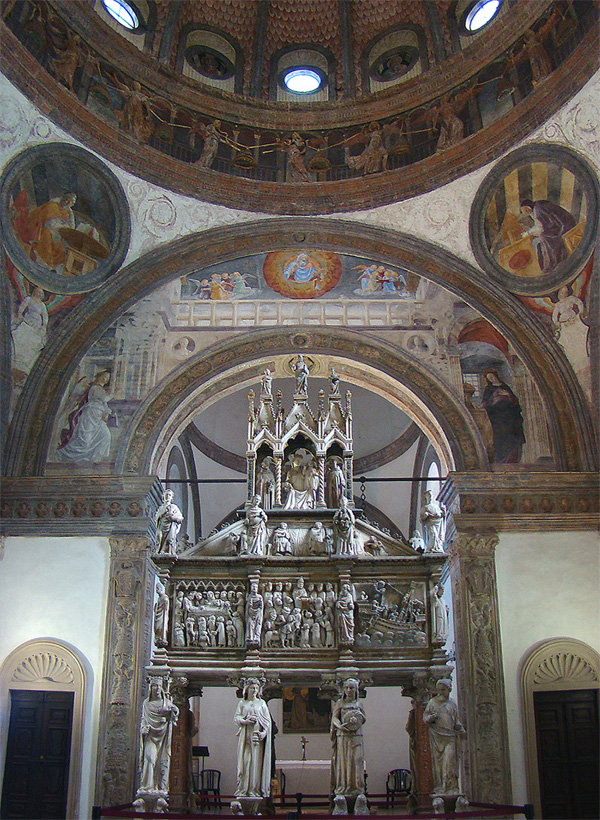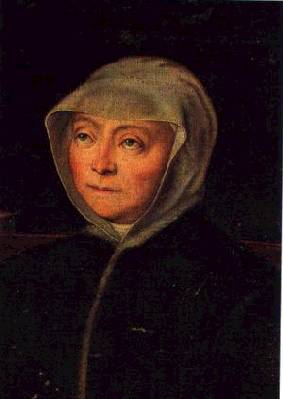|
Melchiorre Crivelli
Melchiorre Crivelli ( la, Melchior Cribellus; 1486–1561) was a Roman Catholic prelate who served as General Inquisitor in the Duchy of Milan from 1518 to 1553, and as auxiliary bishop of Vercelli, Milan and Vigevano. He was an exponent of the early Catholic Reformation. Biography He was born in Milan and joined the Dominican Order in the convent of Sant'Eustorgio. He studied theology at the University of Pavia, obtaining a master's degree. On August 24, 1518, Pope Leo X appointed him as General Inquisitor of Milan, even if probably he took the office of Inquisitor only in 1521. In 1538, he compiled the first Index Librorum Prohibitorum in the territory of Italy, published by the Senate of Milan. This list of books dangerous for the Catholic faith included 46 entries, among them books of Jan Hus, John Wycliffe, Luther, Philip Melanchthon and Johannes Oecolampadius, as well as the ''Instruction et confession de foy'' of Calvin. In 1540, Crivelli was appointed titular bishop ... [...More Info...] [...Related Items...] OR: [Wikipedia] [Google] [Baidu] |
Basilica Of Sant'Eustorgio
The Basilica of Sant'Eustorgio is a church in Milan in northern Italy, which is in the Basilicas Park city park. It was for many years an important stop for pilgrims on their journey to Rome or to the Holy Land, because it was said to contain the tomb of the Three Magi or ''Three Kings''. Probably founded in the 4th century, its name refers to Eustorgius I, the bishop of Milan to whom is attributed the translation of the supposed relics of the Magi to the city from Constantinople in 344. In 1764, when an ancient pillar was removed, a Christian burial was discovered, housing coins of emperor Constans, the son of Constantine the Great. The church was later rebuilt in Romanesque style. In the 12th century, when Milan was sacked by Frederick Barbarossa, the relics of the Magi were appropriated and subsequently taken to Cologne. It was only in 1903/4 that fragments of the bones and garments were sent back to Sant'Eustorgio's. Nowadays they are in the Three Kings altar nearby th ... [...More Info...] [...Related Items...] OR: [Wikipedia] [Google] [Baidu] |
Vigevano
Vigevano (; lmo, label= Western Lombard, Avgevan) is a town and ''comune'' in the province of Pavia, Lombardy in northern Italy. A historic art town, it is also renowned for shoemaking and is one of the main centres of Lomellina, a rice-growing agricultural district. Vigevano received the honorary title of city with a decree of Duke Francis II Sforza on 2 February 1532. It is famed for its beautiful Renaissance "''Piazza Ducale''" in the centre of the town. History The earliest records of Vigevano date from the 10th century AD, when it was a favoured residence of the Lombard king Arduin, for the sake of the good hunting in the vicinity. Vigevano was a Ghibelline commune, favoring the Emperor and was accordingly besieged and taken by the Milanese in 1201 and again in 1275. In 1328 it finally surrendered to Azzone Visconti, and thereafter shared the political fortunes of Milan. The Church of San Pietro Martire (St Peter Martyr) was built, with the adjacent Dominican convent ... [...More Info...] [...Related Items...] OR: [Wikipedia] [Google] [Baidu] |
Giovanni Angelo Arcimboldi
Giovanni Angelo Arcimboldi (1485–1555) was a Roman Catholic prelate who served as Bishop of Novara (1526–1550) ''(in Latin)'' and Archbishop of Milan (1550–1555). ''(in Latin)'' Biography Giovanni Angelo Arcimboldi was born in Milan, Italy on 27 September 1485. On 2 March 1526, he was appointed during the papacy of Pope Clement VII as Bishop of Novara. On 22 May 1526, he was consecrated bishop by Antonio Maria Ciocchi del Monte, Cardinal-Bishop of Porto e Santa Rufina, with Giovanni Maria Ciocchi del Monte, Archbishop of Manfredonia, and Bernardo Ruggieri, Bishop of Sora, serving as co-consecrators. On 19 March 1550, he was appointed during the papacy of Pope Julius III as Archbishop of Milan. He served as Archbishop of Milan until his death on 6 April 1555. Episcopal succession While bishop, he was the principal consecrator of: * Francesco Bernardino Simonetta, Bishop of Perugia (1540); and *Martín Pérez de Ayala Martín Pérez de Ayala (11 November 1504 – ... [...More Info...] [...Related Items...] OR: [Wikipedia] [Google] [Baidu] |
Angelic Sisters Of Saint Paul
, image =File:ASP-AngelicheSPaolo.jpg , imag_size = , caption = Emblem ASP , abbreviation = ASP , motto = , formation = , founder = Anthony Mary Zaccaria , founding_location = Milan, Italy , type = Catholic religious order , headquarters = Milan, Italy , leader_title = Superior General , leader_name = Mo. Elaine Alnaissi, ASP , leader_title2 = Ministry , leader_name2 = , leader_title3 = Patron , leader_name3 = , main_organ = Barnabite Publications , parent_organization = Catholic Church , website = https://www.barnabites.com/angelic-sisters-of-st-paul/ The Angelic Sisters of Saint Paul ( la, Sorores Angelicae Sancti Pauli) are a Roman Catholic religious order founded by Anthony Maria Zaccaria in Milan, Italy in 1535. The order is a female branch of the Barnabite Fathers. Their purpose was to be ... [...More Info...] [...Related Items...] OR: [Wikipedia] [Google] [Baidu] |
Ludovica Torelli
Ludovica Torelli (26 September 1500 – 28 October 1569) was ruling Countess of Guastalla in 1522–1539. A philanthropist, she was instrumental in the founding of two religious institutes for woman: the Angelic Sisters of Saint Paul and the "Collegio della Guastalla"/"Daughters of Mary". Life She was the daughter of Achille Torelli, Count of Guastalla and his wife, Veronica Pallavicini. Her younger brother Francesco died at a young age, leaving her sole heir. Her father died in battle at Luzzara in 1522, making her Countess of Guastalla. She devoted herself to parties, studies, pomp, court life and all that involved her role as Countess. In 1521, her four-year old son Achille died, and then her husband, Cremonese nobleman Count Ludovico Stanghi. She remarried in 1525 Antonio Martinengo. Martinengo was a violent individual, impatient to gain control of her estates. On more than one occasion he forced her to go hunting with him, on a recalcitrant horse, over dangerous terrain. ... [...More Info...] [...Related Items...] OR: [Wikipedia] [Google] [Baidu] |
Barnabites
The Barnabites ( la, Barnabitum), officially named as the Clerics Regular of Saint Paul ( la, Clerici Regulares Sancti Pauli), are a religious order of clerics regular founded in 1530 in the Catholic Church. They are associated with the Angelic Sisters of St. Paul and the members of the Barnabite lay movement. Establishment of the Order Second in seniority of the orders of regular clerics (the Theatines being first), the Barnabites were founded in Milan, by Anthony Mary Zaccaria, Barthélemy Ferrari, and Jacopo Antonio Morigia. The region was then suffering severely from the wars between Charles V and Francis I, and Zaccaria saw the need for radical reform of the Church in Lombardy, afflicted by problems typical for that era: dioceses without a bishop, clergy with inadequate theological training, a decrease in religious practice, and monasteries and convents in decline. It was approved by Pope Clement VII in the brief ''Vota per quae vos'' on 18 February 1533. Later approv ... [...More Info...] [...Related Items...] OR: [Wikipedia] [Google] [Baidu] |
Antonio Maria Zaccaria
Anthony Maria Zaccaria, CRSP (Italian: Antonio Maria Zaccaria; 1502 – 5 July 1539) was an early leader of the Counter Reformation, the founder of religious orders (Barnabites) and a promoter of the devotion to the Passion of Christ, the Eucharist and the renewal of the religious life among the laity. He is venerated as a saint in the Catholic Church, which celebrates his feast day on 5 July. Life Anthony Zaccaria was born in the city of Cremona, Italy, in December 1502 to Lazzaro and Antonia Pescaroli Zaccaria. He was baptized the same day in Cremona Cathedral, probably by his uncle Don Tommaso Zaccaria, canon of the cathedral. When he was two, his father died. His family was of the nobility, and in order to teach him compassion for the poor, his mother made him her almoner. After attending the Episcopal School annexed to the cathedral, he studied philosophy at the University of Pavia, and, from 1520, medicine at the University of Padua. After completing studies in 1524, h ... [...More Info...] [...Related Items...] OR: [Wikipedia] [Google] [Baidu] |
Confirmation In The Catholic Church
Confirmation, in the Catholic Church, is one of the seven sacraments. It is also one of the three sacraments of initiation into the Catholic Church, the other two being Baptism and Holy Communion. Description The ''Catechism of the Catholic Church'' states: It is evident from its celebration that the effect of the sacrament of Confirmation is the special outpouring of the Holy Spirit as once granted to the apostles on the day of Pentecost... Recall then that you have received the spiritual seal, the spirit of wisdom and understanding, the spirit of right judgment and courage, the spirit of knowledge and reverence, the spirit of holy fear in God's presence. Guard what you have received. God the Father has marked you with his sign; Christ the Lord has confirmed you and has placed his pledge, the Spirit, in your hearts. The ''Catechism of the Catholic Church'' sees the account in the Acts of the Apostles as a scriptural basis for Confirmation as a sacrament distinct from Baptism: ... [...More Info...] [...Related Items...] OR: [Wikipedia] [Google] [Baidu] |
Canonical Visitation
In the Catholic Church, a canonical visitation is the act of an ecclesiastical superior who in the discharge of his office visits persons or places with a view to maintaining faith and discipline and of correcting abuses. A person delegated to carry out such a visitation is called a visitor. When, in exceptional circumstances, the Holy See delegates an apostolic visitor (or visitors) "to evaluate an ecclesiastical institute such as a seminary, diocese, or religious institute [...] to assist the institute in question to improve the way in which it carries out its function in the life of the Church," this is known as an apostolic visitation. Usage The practice was reaffirmed in the Catholic Church by the Council of Trent (1545 to 1563) in these words: Of the purpose of visitation the Council says: Rights of visitation The right of visitation belongs to all prelates who have ordinary jurisdiction over persons in the external forum. The pope through his delegates may institute a ... [...More Info...] [...Related Items...] OR: [Wikipedia] [Google] [Baidu] |


